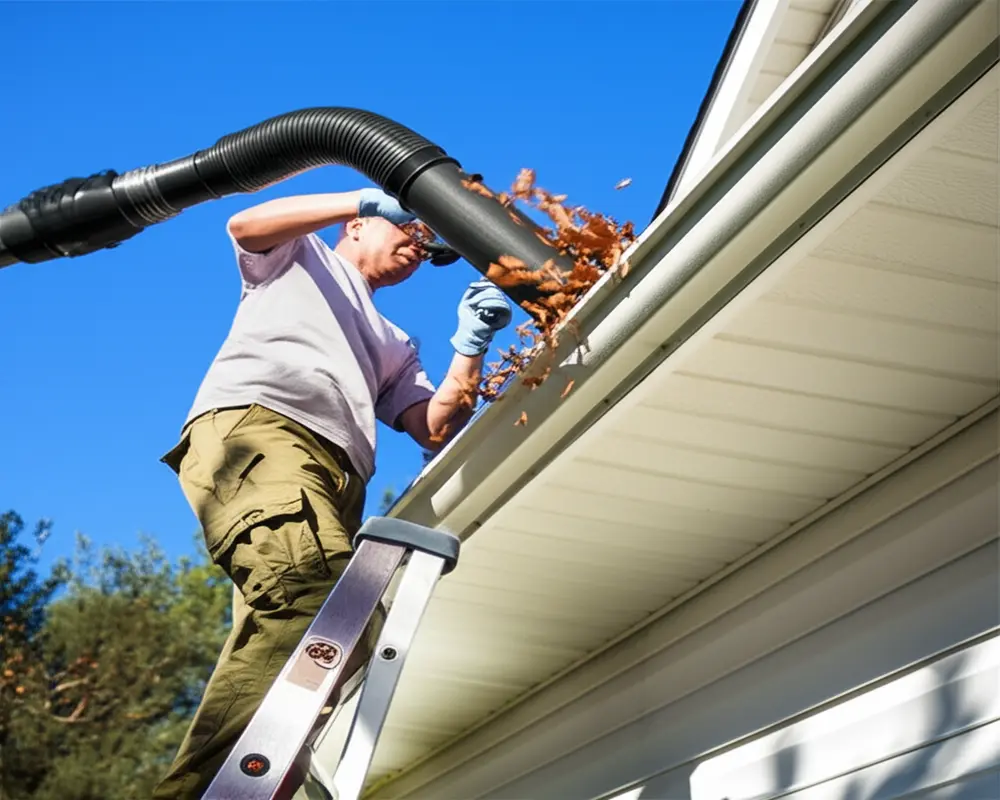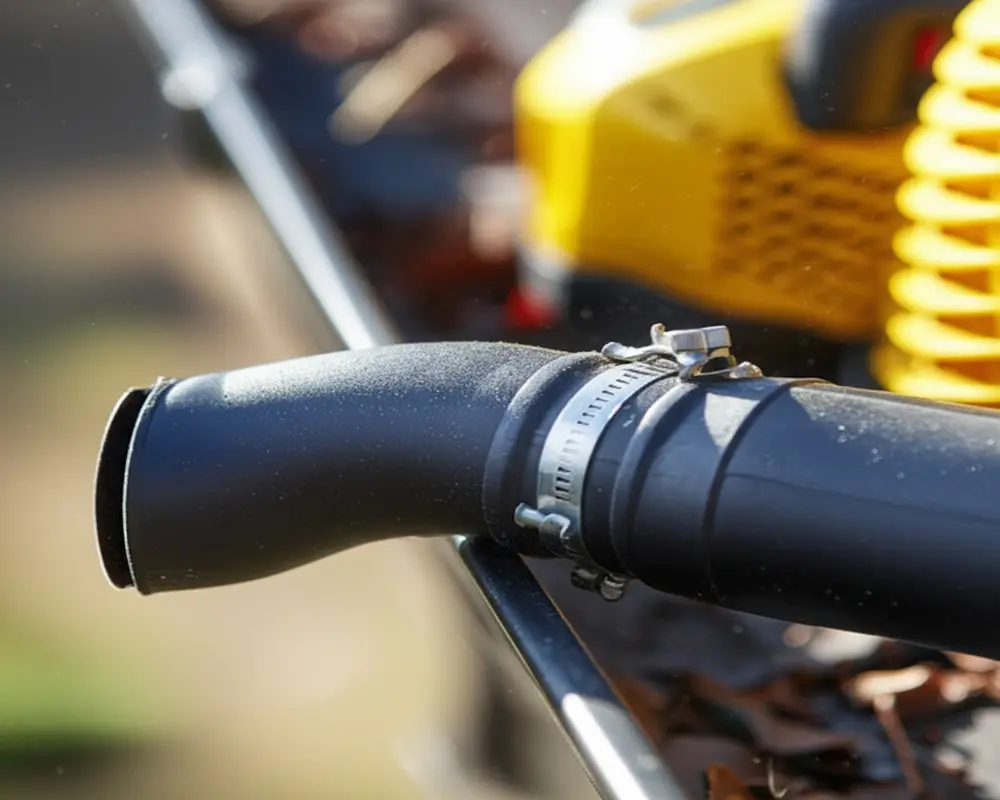Leaf Blower Gutter Cleaning: Safe & Efficient Gutters
Introduction
Using a leaf blower for gutter cleaning has become a popular method for homeowners aiming to maintain clear gutters efficiently. This approach offers significant advantages, primarily in terms of speed and reducing direct contact with debris. Instead of climbing onto ladders with gloves and scooping out muck by hand, a leaf blower can swiftly clear out dry, loose leaves and similar lightweight debris from gutters and downspouts.
This comprehensive guide covers best practices for gutter cleaning with leaf blower techniques, including recommended tools, safety protocols, attachments, and expert tips. Readers can expect a detailed walkthrough of how to safely and effectively maintain gutters using this method, emphasizing precautions when working at heights and handling equipment. The focus will be on dry and loose debris types, as these are best suited for leaf blower use.
Safety First
Working at Heights
Safety must be your top priority when cleaning gutters, as working on ladders involves inherent risks. Choose a ladder that suits the height of your gutters—typically, an extension ladder with stabilizers is ideal for maintaining secure footing, especially on uneven ground. Always ensure the ladder is placed on a firm, level surface to prevent tipping.
Maintain three points of contact with the ladder at all times—two hands and one foot, or two feet and one hand—to maximize stability. Avoid overreaching; instead, move the ladder as needed to keep your center of gravity balanced. Plan your cleaning path to minimize awkward positions, and be aware of overhead power lines or other electrical hazards near your work area. For authoritative guidelines on ladder safety, consult OSHA’s recommendations at OSHA Ladder Safety.
Personal Protective Equipment (PPE)
Protective gear is essential to safeguard against flying debris and noise. Use eye protection such as goggles or safety glasses to shield your eyes from leaves and dirt blown by the leaf blower. Given the considerable noise generated by leaf blowers, wearing hearing protection like earplugs or earmuffs helps prevent hearing damage.
Gloves improve your grip on tools and protect your hands from cuts or scrapes. Long sleeves are recommended to guard against sun exposure and debris contact. If dust or allergens are a concern, a dust mask or respirator—preferably a P100 mask—can filter fine particles effectively during cleaning.
Other Safety Checks
Before you begin, clear the area beneath your gutters of children, pets, and obstacles to avoid accidents from falling debris. Inspect your gutters for any structural damage that might worsen under the pressure of blowing or your weight on ladders. Check the weather forecast: choose dry, calm days without rain or strong wind, and avoid icy conditions that increase fall risks.
Whenever possible, have a spotter or helper nearby who can assist in case of emergencies and help stabilize your ladder. This extra layer of safety is especially valuable for those less experienced with gutter maintenance.
Tools & Attachments for Gutters
Leaf Blower Types & Suitability
Selecting the right leaf blower is crucial for effective gutter cleaning. Handheld electric blowers, whether corded or cordless, are lightweight and generally quieter, making them suitable for small to medium-sized homes with accessible gutters. However, they may lack the power needed for extensive or heavily clogged gutters, and cordless models require battery management.
Backpack leaf blowers, available in gas or electric versions, deliver higher air velocity and longer run times, suitable for larger properties or tougher debris. Their increased weight and noise levels are trade-offs but offer superior performance in demanding scenarios. Deciding between cordless and corded models hinges on your property’s size and mobility needs.
Gutter Cleaning Attachments
Specialized leaf blower attachments for gutters enhance the precision and safety of your work. Curved nozzles and extension tubes allow you to direct airflow into tight corners and deep inside gutters and downspouts, reducing the need to lean dangerously out of the ladder’s safe zone.
Before purchasing, verify attachment compatibility with your blower model. Many manufacturers offer adapters or quick-connect systems for ease of use. While some DIY alternatives exist, investing in dedicated gutter cleaning kits tends to deliver better results and durability.

For a detailed visual of these attachments in action, see the close-up image of the curved gutter nozzle and extension tube attached to a leaf blower below:

Other Essential Tools
In addition to the leaf blower and its attachments, a sturdy ladder equipped with stabilization gear is essential. Consider using a safety belt when working at greater heights. A trowel or scoop is helpful for removing stubborn or compacted debris that the blower cannot dislodge.
After blowing out the gutters, a garden hose with a nozzle attachment can rinse remaining residue and test downspout flow. To manage the debris falling to the ground, use a bucket or tarp to reduce cleanup time and prevent yard mess.
Preparation & Setup
Pre-Job Checks
Before climbing the ladder, gather all necessary equipment: PPE, the leaf blower with gutter attachments, ladder, and ground cover like tarps. Inspect your gutters to identify any large clogs, such as branches or bird nests, which may require manual removal before using the blower.
Plan your cleaning route by marking downspout locations and corners to ensure a systematic approach that avoids missing spots or redoing areas.
Site Setup
Set up your ladder securely, using stabilizers and ensuring the base is on stable ground. Clear the area beneath the gutters to avoid tripping hazards or damage from falling debris.
If you have a helper, establish clear communication signals for safety and coordination during the cleaning process.
Step-by-Step Guide: How to Clean Gutters with a Leaf Blower
The Blowing Technique (core method)
Begin at the lowest point of your gutter system and work upward toward the downspouts or outlets. Aim the blower nozzle downward and slightly forward to guide debris toward these exits. Use short, controlled bursts rather than continuous blowing to avoid overheating the equipment and scattering debris unpredictably.
Carefully maneuver the nozzle around gutter corners and downspout openings, adjusting angles to ensure thorough clearing without risking balance or control.
Handling Different Climates & Debris
This method works best for dry leaves, pine needles, and similarly light organic debris. Wet or compacted leaves, mud, or heavy debris often resist blowing and should be cleared manually first to prevent clogging or damage.
Post-Blowing Checks
After blowing, inspect gutters and downspouts for any residual debris or blockages. Use a garden hose to flush the gutters and check water flow through downspouts. Clean up any debris on the ground to prevent slips or damage to plants and property. Also, look for any damage caused during cleaning to address promptly.

Effectiveness, Limitations & Best Use Scenarios
Ideal Conditions for Leaf Blower Gutter Cleaning
Leaf blower cleaning excels when dealing with dry, loose debris in accessible gutters that are maintained regularly. It significantly reduces cleaning time and minimizes physical strain compared to manual scooping.
When It Is Not Effective
Wet, compacted leaves, heavy debris, gritty shingle residue, and gutters fitted with mesh guards or screens can hinder blower performance. In such cases, manual cleaning or specialized tools may be necessary.
Potential Downsides & Mess
Blowing debris can scatter onto roofs, yards, and walkways, potentially creating a mess. Use tarps or drop cloths to catch falling debris and consider wind direction to minimize spread.
Realistic Expectations
While leaf blower gutter cleaning is a valuable maintenance tool, it is not a catch-all solution. Periodic manual cleaning may still be required to address stubborn clogs or debris types unsuited to blowing.
Leaf Blower vs Other Gutter Cleaning Methods
Manual Cleaning by Hand
Manual cleaning offers thoroughness and direct control, particularly for wet or compacted debris, but it is labor-intensive and increases contact with potentially hazardous waste.
Wet/Dry Vacuums for Gutters
Wet/dry vacuums contain debris better and handle wet material but are bulkier and noisier. They require specific attachments and can be less maneuverable than blowers.
Gutter Cleaning Robots & Automated Tools
Robotic cleaners offer convenience for routine maintenance but come with high upfront costs and limited capability for heavy blockages or intricate gutter designs.
Professional Gutter Cleaning Services
Hiring professionals eliminates personal risk and effort, providing expert cleaning with specialized tools. However, cost considerations and scheduling may be less flexible.
Decision Framework
Choose leaf blower gutter cleaning when dealing with dry, loose debris in accessible gutters and when seeking a balance of efficiency and cost. Opt for manual, vacuum, robotic, or professional methods depending on debris type, gutter design, and personal comfort with ladder work.
Advanced Tips & Troubleshooting
Dealing with Stubborn Wet Spots
For wet or compacted debris, pre-clean manually using a trowel or scoop before employing the blower. This approach prevents clogging and ensures more effective clearing.
Managing Dust & Debris
Use tarps and consider wind direction to reduce dust and debris dispersal. Shield yourself with appropriate PPE to minimize inhalation and eye irritation.
Reaching Difficult Areas
Employ longer or flexible attachments to access tight or awkward gutter sections without compromising safety. Adjust nozzle angles to navigate around obstacles effectively.
Downspout Clogs & Flush Tests
After clearing gutters, check downspouts for blockages. Flush with a garden hose to confirm unobstructed water flow, clearing any clogs found.
Seasonal Considerations
Plan gutter cleaning in alignment with local leaf drop patterns, typically in late fall and early spring. Regular maintenance during these periods helps prevent accumulation and damage.
Gutter Maintenance Schedule & Prevention
How Often to Clean
Generally, gutters should be cleaned two to four times annually, depending on tree coverage and local climate. More frequent cleaning may be necessary for heavily wooded areas.
Preventive Tips
Installing gutter guards, trimming overhanging branches, and routinely inspecting downspouts can significantly reduce debris buildup. Scheduling regular maintenance ensures gutters function optimally year-round.
Troubleshooting Guide: FAQs & Quick Answers
- Is using a leaf blower for gutters safe?
Yes, when following proper safety procedures, including ladder safety and PPE use, leaf blower gutter cleaning is safe. - What blower is best for gutter cleaning?
Backpack leaf blowers offer higher power for extensive cleaning, while handheld cordless models suit smaller jobs. Attachments are essential for precision. - Can I use a blower on wet leaves?
Wet leaves are difficult to blow and may require manual removal first for best results. - How often should gutters be cleaned?
Typically, 2-4 times per year depending on environmental factors. - Do leaf blower gutter attachments work?
Yes, specialized attachments like curved nozzles and extension tubes improve efficiency and safety.
Visual Content Strategy & UX Tips
Image Plan
Key images should include ladder setup showing stabilizers, the leaf blower in action with gutter attachments, and before-and-after shots of gutter cleaning results to visually guide users through the process.
Accessibility & Alt Text
All images must have descriptive alt text incorporating keywords such as leaf blower gutter cleaning, gutter attachments, and safety to improve SEO and accessibility for screen readers.
Internal & External Linking Plan
Link internally to related guides such as backpack leaf blower reviews to provide product options. Externally, authoritative resources like OSHA ladder safety and Bob Vila’s gutter cleaning guide enhance trustworthiness.
Content & SEO Strategy Notes (Contextual Structure)
Macro vs Micro Contexts
The article’s headings are structured hierarchically to provide semantic clarity and reinforce the primary topic of leaf blower gutter cleaning. Each subsection builds on the preceding one, maintaining a natural flow of information that supports both the main keyword and related terms.
Contextual Bridges & Linkless Connections
Anchor phrases such as “gutter cleaning with leaf blower” and “leaf blower attachments for gutters” link subtopics logically back to the main context without redundancy. This approach ensures a smooth narrative while optimizing semantic relevance.
Q&A & Question Generation
Including common questions and direct answers in the FAQ section enhances user engagement and increases the likelihood of appearing in featured snippets on search results pages.
Image & Table Layout Plan (for article production)
Image placements
Place the leaf blower gutter setup image near the discussion of tools and attachments. The close-up of gutter cleaning attachments should accompany that subsection. The before-and-after image fits best when addressing effectiveness and results.
Table of Gutter Cleaning Methods
| Method | Pros | Cons |
|---|---|---|
| Manual Cleaning | Thorough; direct control | Time-consuming; direct contact with debris |
| Leaf Blower | Fast; reduces manual contact | Scatters debris; less effective on wet clogs |
| Wet/Dry Vacuum | Contains mess; handles wet debris | Bulky; noisy; requires attachments |
| Robotic Tools | Convenient; automated | Expensive; not ideal for heavy clogs |
| Professional Services | No effort; expert cleaning | Cost; scheduling |
Content tables alignment with headings
Alt text for each image and table includes targeted keywords to maintain semantic consistency across the article, aiding in SEO and accessibility.
Conclusion
Leaf blower gutter cleaning offers a safe, efficient approach to maintaining gutters when combined with proper safety measures, suitable tool selection, and effective technique. Adopting this method can significantly reduce the time and physical strain involved with gutter upkeep while minimizing debris contact.
Consider your specific property conditions, gutter type, and debris nature to determine if leaf blower cleaning fits your needs. When used appropriately, it serves as a valuable maintenance tool that complements other cleaning methods. Prioritize safety and thoroughness for the best results.
Visuals & Signals Summary
This guide incorporates three key images with descriptive alt text related to leaf blower gutter cleaning, gutter attachments, and safety. External links to respected sources bolster the article’s authority, helping search engines recognize its trustworthiness and relevance.
External Signals & Authority
- OSHA Ladder Safety
- Bob Vila – How to Clean Gutters
- This Old House – Gutter Cleaning
- Family Handyman – Cleaning Gutters
- The Spruce – Roof and Gutter Maintenance
For ongoing updates and related maintenance guides, monitoring these resources ensures the latest safety standards and techniques.
Quick Reference (Optional in article)
- Use a sturdy ladder with stabilizers and maintain three points of contact.
- Wear eye, ear, hand, and respiratory protection.
- Choose leaf blower type based on gutter size and debris.
- Attach curved nozzles and extensions for precision cleaning.
- Start blowing from the lowest gutter point toward downspouts.
- Clean gutters 2-4 times annually, more if heavily shaded by trees.
- Leaf blowers work best on dry, loose debris; manual cleaning may be needed for wet or compacted clogs.

